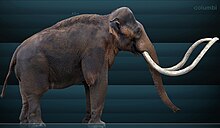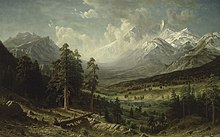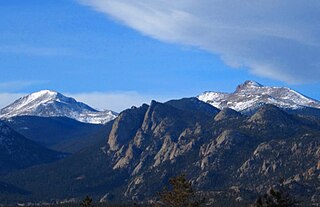Early history
Paleo-Indians

People have been visiting the area near Rocky Mountain National Park for at least 11,000 years, including the Lindenmeier and Dent sites where projectile points were found that were used to hunt Mammoth [15] and Bison antiquus . [1] Both Clovis and Folsom projectile points have been found in the park, [16] some near Trail Ridge. This indicates that there were early hunters, or Paleo-Indians, of large and now extinct mammals, like mastodons and bison antiquus, that traveled through the park. Their shelters were animal hide tents, brush huts, or rock shelters. [1] They traveled into the Rocky Mountain National Park area using a trail that is now Trail Ridge Road. [2]
The Paleo-Indians began hunting smaller, modern bison and looked for many sources of food in nature when they adopted the lifestyle of the Archaic period about eight thousand years ago. Projectile points have been found at Fall River Pass, on Flattop Mountain, at Forest Canyon Pass, on a slope above Chapin Pass, near Oldman Mountain, and other places in the park. Archeologist Wilfred M. Husted said, "Evidence indicates intermittent occupation of the Park rather than continuous occupation. Travel back and forth across the Continental Divide was the primary reason why Indians entered the mountains. Small camps indicate seasonal hunting in the valleys and on the mountains." [1]
Within the park there are archeological remains from about 3,850 to 3,400 B.C. of 42 low-walled stone structures or cairns, up to hundreds of feet in length, built for game drive systems. [17] Remains of such structures were found on Mount Ida, Tombstone Ridge, and on Trail Ridge Road. [18] These slight walls served as devices that permitted hunters to direct or herd game animals—like bison, sheep, deer, or elk— toward men waiting with weapons. Up to twenty-five people may have been needed to execute the game drive. Hunters may have killed the animals using darts, atlatl, spear throwers, or spears tipped with stone projectile points. [17] A game drive sites was used in this timeframe in an alpine area south of the park (like Mount Albion complex). Since they were temporary camping sites, it was assumed that people still came to the area to hunt and did not live in the mountainous region during the winter. [15]
Bows and arrows were used to hunt animals by 400 to 650 A.D., [15] [1] and pottery pieces have been found in the park that are dated to this period of time. [1] The Paleo-Indians also continued to use game drives to hunt for meat until about 1000 AD. [15] As hunter-gatherers, they also foraged for roots and berries for sustenance. [15]
Native Americans

Between 1000 and 1300 AD, Ute people moved into the Rocky Mountain and western slope areas of Colorado, perhaps from the Great Basin of Utah. [3] The Ute, who were hunter-gatherers, traveled along Ute trail. Their belongings were carried by the Utes or were pulled by dogs with travois, until they had horses. The Utes camped in bands or small family groupings and stayed in the park area during the summer months and in Estes Park for the winter. Their diet included bison, elk, bighorn sheep, jackrabbit, antelope, deer, berries and roots. [3] When food was scarce, they ate tree bark. [8] In the early 1800s, the Arapaho pushed the Utes out of Estes Park. [8]
In the early 1800s, the northern Arapaho entered into the Rocky Mountain regions of Colorado. At first, they sought lodgepole pines for their tepees from the Kawuneeche Valley. They then spent more time in the Estes Park and surrounding area. The Arapaho also pressed for access to the North Park, Middle Park, and South Park areas, which had been controlled by the Utes. [4] There was a significant battle between the Arapaho and Ute at Grand Lake in which Ute women and children paddled a raft out to the middle of the lake for safety, but were drowned during a sudden storm. [19]
An old Arapaho camp was located at Marys Lake. They had names for many of the sites within the park, often based upon an event or residing animals, which was published in Arapaho Names and Trails. [20] The Arapaho left before 1860 when the area was settled by people of European descent. [8] By 1878, the northern Arapaho were forced into a reservation at Wind River Indian Reservation. [4]

There were three main trails used by the Ute and Arapaho people to travel between Middle Park and Estes Park. One was called Dog Trail, because the Arapaho had dogs pull travois over the snowy trail, is now called Fall River trail. Child's trail has a spot where children had to get off their horses due to the steep terrain; that trail is now Ute Trail and Trail Ridge Road. Big Trail, which went over Flattop Mountain to the Kawuneeche Valley, was used by fast-traveling warriors. [21] Stone cairns were used by the Arapahos and the Utes to mark the forest trails. [22]
There are hundreds of sites with evidence of Native American visits, [23] including Tepee rings found along the Thompson River [24] and other signs of summer camps. [25] Stone and bone tools used for hunting, butchering, processing hides, and cooking have been found in the park. [26] Additionally, Native Americans carried river boulders to the top of Oldman Mountain, the site of their ceremonial vision quests. [25]
The Apache, Cheyenne, Sioux, and Shoshone periodically hunted or raided the area. [23] Comanche people may have also hunted in the Rocky Mountains for hundreds of years. [1]



















